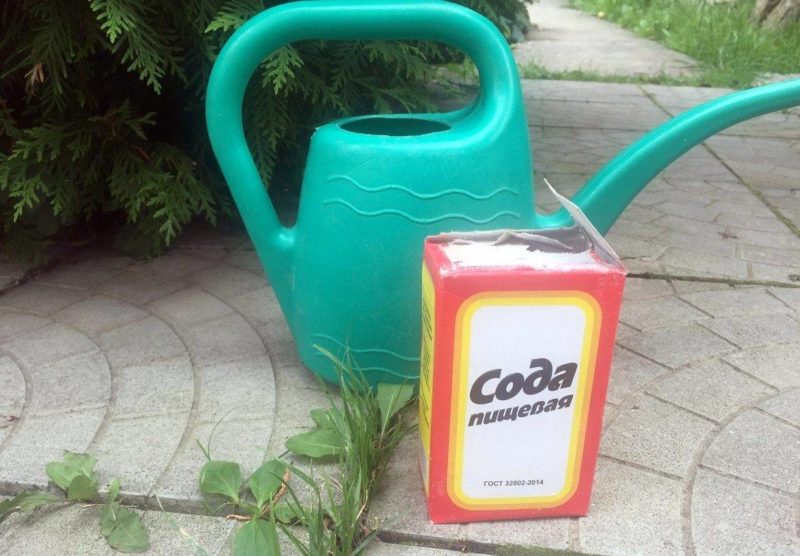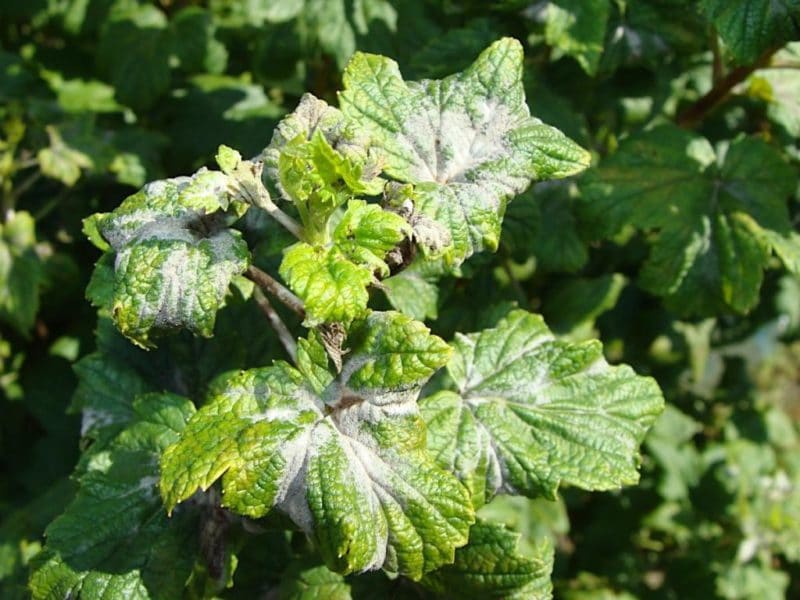How to properly use soda against powdery mildew on currants and how effective it is
Faced with the problem of currant bushes being affected by powdery mildew, experienced gardeners often use baking soda to combat the disease. The article describes how effective this product is, as well as how to properly prepare and use working solutions.
Why use soda against powdery mildew on currants

A thin grayish-white coating covering the surface of currant shoots and leaf blades is evidence that the crop is suffering from a fungal disease - powdery mildew. Foliage affected by the fungus darkens, becomes deformed and falls off, and the upper parts of the shoots die off.
This problem often arises if the summer season is cold and rainy. Mild winters and sudden warming can also trigger the disease.
In specialized stores for gardeners and gardeners there are many preparations designed to combat powdery mildew. However, many summer residents prefer to use a simple, proven and safe folk remedy for this purpose - the well-known soda.
This decision is based on the fact that the substance:
- has excellent disinfectant properties;
- does not pose a danger to human health;
- harmless to fruit and berry crops and can be used during their active fruiting period;
- accessible and inexpensive.
The use of soda solution as an antibacterial agent is appropriate not only for the prevention of disease, but is also especially important when plants are infected during the appearance of berries, when treatment with chemicals is not possible.
Attention! Using soda to rid currants of powdery mildew has an additional positive effect. The product significantly increases the yield of bushes, improves the taste of berries and protects the plant from insect pests.
The principle of operation of the product
The therapeutic effect of soda solutions is associated with the alkaline properties of the drug.
The causative agent of powdery mildew is a fungus from the powdery mildew family that affects many varieties of red and black currants. A fungal disease develops successfully in an acidic environment, and the presence of soda changes it to an alkaline one, which is destructive for pathogenic microflora.
The benefits of the substance are not limited to the antifungal effect. The drug also:
- enriches the soil with sodium, facilitating more complete absorption of nutrients by the plant;
- alkalizes the soil, which is beneficial for currants;
- increases crop resistance to diseases and pests;
- works as a growth stimulator;
- prolongs the fruiting period of the bush and increases its yield by 20-30%.
Which soda to use
Before you start treating currants for fungus, you should decide what kind of soda - baking soda or soda ash - to use for this.
Food
Sodium bicarbonate, or sodium bicarbonate (NaHCO3), is a food additive widely used in baking and cooking. When dissolved in water, NaHCO3 gives a slightly alkaline reaction. The pH value of baking soda is pH 8.
The substance works effectively as a preventive and therapeutic agent against powdery mildew and other fungal diseases, as well as:
- helps cope with weevils and aphids on currants;
- used for spraying shrubs to increase its productivity.
Calcified
Sodium carbonate, or sodium carbonate (NaCO3), dissolved in water, being a strong alkali, is used exclusively for technical purposes. The product belongs to hazard class III and has a pH value of 11.
In gardening, sodium carbonate solution is used for:
- disinfection of currant seedlings before planting in the ground;
- combating slugs and aphids on crops;
- spraying currant bushes when affected by powdery mildew, gray rot and other fungi.
This is interesting:
How and with what to spray currants in the spring against pests and diseases
Step-by-step instructions on how to prune currants in the spring for a good harvest
How to prepare the product
In order for the treatment of plants to be effective and safe and not cause burns to the foliage, it is necessary to observe the correct dosage when preparing working solutions, taking into account that the calcined variety of the substance, as a stronger alkali, will be needed 5 times less than food grade.
Important! The container in which the composition is mixed should not be metal, since an aqueous solution of soda has pronounced alkaline properties and reacts chemically with metals. The best option is a regular plastic bucket.
To ensure complete dissolution of the active substance, warm water is used to prepare the product.However, the temperature of the liquid should not exceed +50°C, since at higher temperatures the alkaline properties of the soda solution increase, which can harm the plants.
Recipes for solutions
The working compositions used for spraying currants include 2 main substances in different proportions:
- water;
- baking soda or soda ash.
To ensure that the medicinal mixture remains on the bushes as long as possible, laundry soap is added to the composition.
To prepare the most popular base solution:
- 50 g of laundry soap is cut into small shavings or crushed on a coarse grater.
- Bring 2 liters of water to a boil.
- The soap is placed in boiling water and stirred until completely dissolved.
- After the temperature of the mixture drops to +40...+50°C, add 2 tbsp. l. calcined or 10 tbsp. l. baking soda.
- After thoroughly mixing the components, combine them with 8 liters of cold water, resulting in a ready-to-use product at room temperature.
The same procedure is followed when preparing other working solutions. Their composition is slightly different from the basic one:
- Tank mixture for controlling diseases and pests (per 10 liters of water):
- 30 g laundry soap;
- 1 tbsp. l. NaCO3 or 5 tbsp. l. NaHCO3;
- 200 g wood ash.
- Water diluted in a bucket works effectively:
- 50 g soap;
- 20 g soda ash;
- 20 g of onion pulp.
For greater convenience, bar soap can be replaced with a liquid version.
To maximize the preventive and therapeutic properties of the product, use the following composition:
- In 1 liter of water heated to + 40°C, dilute 2 tbsp. l. liquid soap.
- Add 2 tbsp. l. sodium carbonate or 10 tbsp. l. hydrocarbonate.
- Stir thoroughly.
- Add 1 tsp. Yoda.
- Pour 9 liters of clean water and mix again.
Adding yeast to the product allows you not only to rid currants of powdery mildew, but also at the same time feed the plant.
Prepare the working staff as follows:
- 0.5 kg of baker's yeast is diluted in 5 liters of warm water.
- Mix with 0.1 kg of baking soda.
- Leave for 24 hours.
- Add water, bringing the total volume to 10 liters.
- Mix thoroughly.
The resulting composition is used to treat the bush 3 times per season:
- during bud formation;
- during the flowering period;
- after harvest.
For greater efficiency, laundry soap is replaced with tar soap and garlic is added to the composition:
- Finely chop 150 g of garlic and leave in a bucket of water for 6 hours.
- The resulting infusion is supplemented with 10 tbsp. l. drinking or 2 tbsp. l. soda ash.
- Pour in 100 g of liquid tar soap.
To successfully combat powdery mildew and better adherence of the medicinal mixture to currant leaves, add vegetable oil to the solution:
- 1 liter of water is heated until warm.
- Add 4 tsp. NaHCO3.
- Stir.
- Pour 1 tbsp. l. vegetable oil.
- Shake thoroughly.
Rules of application
When processing shrubs, you should adhere to certain rules. This will increase the efficiency and reliability of the procedure.
Attention! The soda solution retains its beneficial properties for 3 hours, after which its activity gradually decreases due to the rapid decomposition of the active substance. Therefore, the bush is treated with a freshly prepared composition.
The procedure is carried out in dry, windless weather, mixing the working solution until smooth and generously spraying the trunk, shoots and leaves of the currant not only from the outside, but also from the back using:
- hand spray;
- special garden sprayer;
- an ordinary broom, dipping it into the working solution and watering the bush as evenly as possible.
The latter device should not be used unless absolutely necessary, as in this case the consumption of the product will increase and the processing efficiency will decrease.
The best option is a garden sprayer, which provides high quality spraying and minimal solution consumption.
Processing is carried out starting from the bottom of the bush and gradually moving upward.
Reference. Currant bushes affected by powdery mildew are treated with a base solution once every 6-7 days, early in the morning or in the evening. This allows the product to remain moist for as long as possible, and also protects the leaves from chemical burns when exposed to direct sunlight.
The procedures are continued until the signs of the disease disappear.
Preventive treatment of bushes is carried out immediately before buds open and then once every 15-20 days, excluding:
- flowering time;
- 2 week period before harvest.
To spray one adult currant bush you will need 5 liters of soda solution. The total number of procedures per season is about 5.
Precautionary measures
Sodium bicarbonate does not pose a danger to human health, however, when working with solutions of a calcined type of substance that has pronounced alkaline properties, the risk arises:
- burns of mucous membranes;
- skin irritation.
Therefore, when working with sodium carbonate, you should not neglect personal protective equipment, using:
- a respirator to prevent the product from entering the respiratory tract;
- rubber gloves to protect against damage to the skin of the hands;
- eye protection glasses;
- long sleeve robe.
Berries treated with soda ash on the eve of ripening should be thoroughly washed with warm water before eating.
Important! If the sodium carbonate solution comes into contact with the skin, immediately rinse the affected area with plenty of cold water.
Expected Efficiency

Soda solution is a highly effective remedy against powdery mildew on currants, but not the only one. There are a number of chemical drugs that help successfully cope with the disease:
- "But".
- "Baktofit".
- "Topsin."
- "Skor."
- "Fitosporin".
- "Nimrod"
- Copper sulfate.
- 0.5% ammonium nitrate solution.
Among the folk remedies for disinfection it is worth noting:
- aqueous solution of iodine (1 bottle per 10 l);
- product based on potassium permanganate (5 g per bucket of water).
The use of chemicals is not possible at all stages of the plant's growing season. In addition, toxic substances:
- sometimes they remain on the berries and enter the human body;
- cause poisoning of domestic animals.
In terms of effectiveness in the fight against fungus, soda is not inferior to other folk remedies and pesticides.
This is interesting:
Conclusion
The use of soda in the fight against powdery mildew on currants has been tested and approved by many summer residents and owners of personal plots. A competent approach to the preparation of working solutions, precise adherence to proportions and correct implementation of the procedure ensure a good result and help to successfully cope with the problem.